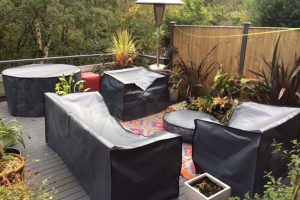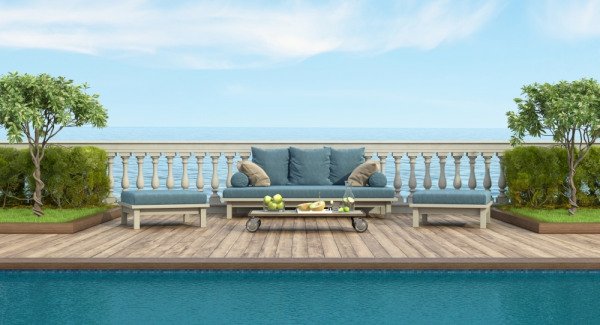Last updated on March 23rd, 2022
Have you ever thought about what could happen if you allowed all that stagnant water to remain on your patio furniture cover for a while? Weak seams, damaged foam insert, sagging fabric, and maybe eventually, a total breakdown of your investment. Patio furniture covers are made to extend the life of your Outdoor furniture, but when you allow water to log inside them, they can come short in that duty.So, it’s crucial to know how to keep water from pooling on patio furniture cover. There are three main ways to do this – use a self-draining outdoor cover, buckets, or a center shedding pole.
We will consider each one of these methods in greater detail later in the article. But for now, let’s see why it’s important to keep water from pooling on your patio furniture cover in the first place.
Table of Contents
Why keep water from pooling on patio furniture cover
To prevent damage: Outdoor furniture covers are not built to withstand much weight. So, allowing water to pool on them exposes both the cover and your furniture to damage. Even tiny droplets can add up quickly, exerting pressure on the seams. Over time, this makes the seams weak and might eventually lead to collapse. 
Pooling can lead to sagging: For covers with form insert, like the outdoor cushions, waterlogging can cause the foam to break down. This, combined with normal wear and tear, can shorten the useful life of the cover.
To protect the furniture frame: Besides the coves seams, pooling can also put stress on the furniture frame. This can become really bad and expensive if not resolved on time.
To keep your furniture clean and prevent more stress:
During winter, pooled water can freeze on the top shelf of the cover if left alone. This can put more stress on the cover. And when all that dirty water eventually melts, it can get dumped on your garden furniture if not pumped off.
How to keep water from pooling on patio furniture cover
Use Buckets
Before setting up the cover over your furniture set, place one or two buckets in the middle of the table. This helps to create “slanted” sides that allow water to flow downwards from the top.
For patio sets with a higher table than chairs, you don’t need to use buckets. The idea is to have something pushing the cover-up in the center so water can drain off easily.
This method also works when you have an armchair and sofa arrangement shaped into a rectangular. Just place the bucket on the seat to allow the water to drain off.
If you want to stretch things even more, you can fill the bucket with cement and place a broom handle or cane at the center. But normally, using buckets alone is okay.
Use a Self Draining Cover
Few brands offer innovative furniture covers with a self-draining feature. These covers are shaped differently from regular covers. They most likely have an extra shaping on the front to help water drain off more easily.
Sometimes these are custom made and designed to customer specifications. So if you think the standard sizing won’t work for you, you can contact the manufacturer to have your own custom cover made with sloping.
Use a Centre Water Shedding Pole
Shedding poles can also be used to raise covers so water can properly drain away. It is highly recommended for patio sets that include high back chairs and a table with a parasol hole. The pole is placed at the center hole and lifts the cover above the chairs to prevent pooling.
You can use the pole with virtually any furniture set cover as long as the table has a parasol hole.
How to stop water from condensation on outdoor furniture covers
Opt for a water-resistant cover
Waterproof covers don’t allow water in or out; as a result, it’s very easy for moisture to build up inside when there’s no airflow. On the other hand, a water-resistant material will repel water while still offering a breathable design. This allows moisture to evaporate and not get trapped under the cover.
Prioritize Breathability
The best way to avoid pesky condensation issues is to use a highly breathable cover. Such covers usually have a hidden mesh net to get rid of condensation while keeping water out. They tend to be a bit more expensive but offer greater value in the long run, especially on wicker furniture.
Create a Slit on the Sides of the Cover
If you’re already using a waterproof cover, you can upgrade it by cutting a slit into the sides. Then use a piece of wire or straw to line the area with some mesh. The straw or wire helps to keep the slit open, while the mesh provides a channel for moisture to escape and helps to keep debris and insects away.
Though not necessary, you can add another piece of waterproof fabric to overlap with the slit, just to make sure water doesn’t get in. This can be done using glue.
What should I consider when choosing the best outdoor furniture cover?
Sizing
Before you take the plunge on any outdoor furniture cover, first take the measurement of the furniture. Though it may sound ridiculous, most people don’t actually measure their furniture pieces before they get the covers. As a result, they often end up with the wrong sizes, which can be a problem.
Furniture covers are expected to be just above the ground so there can be proper air circulation underneath. This is necessary to prevent mould-and-mildew buildup.
An oversized cover will create pockets that hold water, while an undersized cover will not cover the furniture well. So, the best plan is to find a cover that matches the size of the outdoor piece or set.
Water Protection
Patio furniture covers are typically designed to withstand the elements. So, they basically provide some level of protection from the rain.
However, contrary to popular belief, not all outdoor covers are waterproof. Some are simply water-resistant, which means they can only withstand a little drizzle and will eventually soak in water at some point.
The best outdoor waterproof covers are usually made of vinyl or polyester blends. When water falls on such covers, it rolls off as beads. This ensures both the cover and furniture remain nice and dry.
Shape
When selecting a cover for your patio furniture, it’s not just the textile you want to look at. You should also consider the shape and fitting, as this helps to aid water drainage. A cover with dropped or slanted shoulders will drain water off more easily.
Ideally, the shoulders should be “dropped” or slanted so water can drain off more easily. On the other hand, if the cover is fitted to the same shape as the furniture set, chances are that water will pool on the top.
Breathability
Whether you choose a cover that is water-resistant or waterproof, you want it to come with vents or holes for breathability. This allows air to flow through the cover, which helps to keep the furniture dry. In other words, these holes will enable the cover to breathe. And without them, moisture will be trapped under the cover, which can encourage the growth of mold and mildew in your furniture.
Many breathable covers are not 100 percent waterproof, which is understandable since the vents will allow some water to pass through. If you’re using a thick cover (like vinyl) that doesn’t have enough breathability, you can remove the cover on some days to allow trapped moisture to escape.
Ideally, you want to choose a cover that has both water resistance and breathability.
Tie Downs
Without anything to secure your cover to the furniture, it stands a chance of being blown away during windy conditions. And if the current is high enough, it can tag your furniture along.
Tie-downs ensure this doesn’t happen.
These are usually string ties at the bottom of the cover that enable you to secure the cover to the furniture. This helps to minimize slack, so there’s very little air gusting inside the cover, especially when there’s a storm or strong wind.
Some covers may come with buckles, drawstrings, or some other kind of fastener instead of string ties. These are also fine as long as they secure and keep the cover in place.
Pricing
Outdoor furniture covers come at different prices depending on the type of material, size, and style. It helps to have a particular budget in mind; this helps to narrow down your options. But make sure it’s possible to find a high-quality cover at your chosen price range. Avoid ridiculously low-priced covers by all means!
Ideally, you want a cover that is affordable and suits your preference while offering a high level of protection.
Final Words
There you have it – how to keep water from pooling on patio furniture cover.
Follow the tips above to protect your patio furniture and cover from much wear and damage.
While these covers are great, we encourage you to explore other indoor storage solutions if you want something more long-term.
Let us know if you have any more questions. Till then, have fun getting ready for your summer retreat.
Frequently asked questions
What is a water-shedding pole?
This is a material that is used on furniture set covers, especially on tables with parasol holes to lift the cover up to prevent pooling and protect your patio furniture.
What fabric are patio furniture covers made of?
The most ideal fabric for patio furniture covers is polypropylene fabric. This is the first marine fabric because of its strong UV resistance. Also, it is the best choice for outdoor cushions because it dries faster and does not have dye sites.
How do you keep patio furniture covers from being blown away?
You can secure your patio covers from being blown away using gust guards and bungee cables. Just attach the clips to the corners of the cover and connect each pair of the clips to the four corners and connect with the two-tie down cords.
How do you measure patio furniture covers?
Regardless of the type of your furniture, you are supposed to measure the width, depth and height. The width is measured from the widest point from left to right. Depth is measured starting from front to back from the deepest area. Lastly, height is measured starting from the ground all through to the highest level.
How to use cover clamps on patio furniture?
Even if your patio cover is a perfect fit, it can still be blown away during strong winds use cover clamps correctly to avoid this. After placing the cover, secure the drawcords and buckle straps. Unlock the clamp and secure it on the cover bottom. Place the bungee cords on the cover wheels and attach the hooks on the inserts of the clamps.

